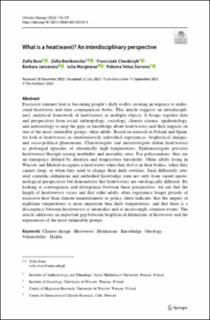| dc.contributor.author | Boni, Zofia | |
| dc.contributor.author | Bieńkowska, Zofia | |
| dc.contributor.author | Chwałczyk, Franciszek | |
| dc.contributor.author | Jancewicz, Barbara | |
| dc.contributor.author | Marginean, Iulia | |
| dc.contributor.author | Serrano, Paloma Yáñez | |
| dc.date.accessioned | 2024-03-06T09:45:55Z | |
| dc.date.available | 2024-03-06T09:45:55Z | |
| dc.date.created | 2023-09-25T09:31:09Z | |
| dc.date.issued | 2023 | |
| dc.identifier.citation | Climatic Change. 2023, 176 (9), . | en_US |
| dc.identifier.issn | 0165-0009 | |
| dc.identifier.uri | https://hdl.handle.net/11250/3121227 | |
| dc.description.abstract | Excessive summer heat is becoming people’s daily reality creating an urgency to understand heatwaves and their consequences better. This article suggests an interdisciplinary analytical framework of heat(waves) as multiple objects. It brings together data and perspectives from social anthropology, sociology, climate science, epidemiology, and meteorology to map the gaps in knowledge about heat(waves) and their impacts on one of the most vulnerable groups: older adults. Based on research in Poland and Spain, we look at heat(waves) as simultaneously individual experiences, biophysical changes, and socio-political phenomena. Climatologists and meteorologists define heat(waves) as prolonged episodes of abnormally high temperatures. Epidemiologists perceive heat(waves) through raising morbidity and mortality rates. For policymakers, they are an emergency defined by duration and temperature thresholds. Older adults living in Warsaw and Madrid recognize a heat(wave) when they feel it in their bodies, when they cannot sleep, or when they need to change their daily routines. Such differently situated scientific definitions and embodied knowledge stem not only from varied epistemological perspectives but demonstrate that heat(waves) are ontologically different. By looking at convergences and divergences between these perspectives, we see that the length of heat(waves) varies and that older adults often experience longer periods of excessive heat than climate measurements or policy alerts indicate; that the impact of nighttime temperatures is more important than daily temperatures; and that there is a discrepancy between heat(waves) as anomalies and as increasingly common events. The article addresses an important gap between biophysical definitions of heatwaves and the experiences of the most vulnerable groups. | en_US |
| dc.language.iso | eng | en_US |
| dc.publisher | Springer Nature ltd | en_US |
| dc.rights | Navngivelse 4.0 Internasjonal | * |
| dc.rights.uri | http://creativecommons.org/licenses/by/4.0/deed.no | * |
| dc.subject | Climate change | en_US |
| dc.subject | Heatwaves | en_US |
| dc.subject | Definitions | en_US |
| dc.subject | Knowledge | en_US |
| dc.subject | Ontology | en_US |
| dc.subject | Vulnerability | en_US |
| dc.subject | Health | en_US |
| dc.title | What is a heat(wave)? An interdisciplinary perspective | en_US |
| dc.title.alternative | What is a heat(wave)? An interdisciplinary perspective | en_US |
| dc.type | Peer reviewed | en_US |
| dc.type | Journal article | en_US |
| dc.description.version | publishedVersion | en_US |
| dc.source.pagenumber | 0 | en_US |
| dc.source.volume | 176 | en_US |
| dc.source.journal | Climatic Change | en_US |
| dc.source.issue | 9 | en_US |
| dc.identifier.doi | 10.1007/s10584-023-03592-3 | |
| dc.identifier.cristin | 2178419 | |
| cristin.ispublished | true | |
| cristin.fulltext | original | |
| cristin.qualitycode | 1 | |

